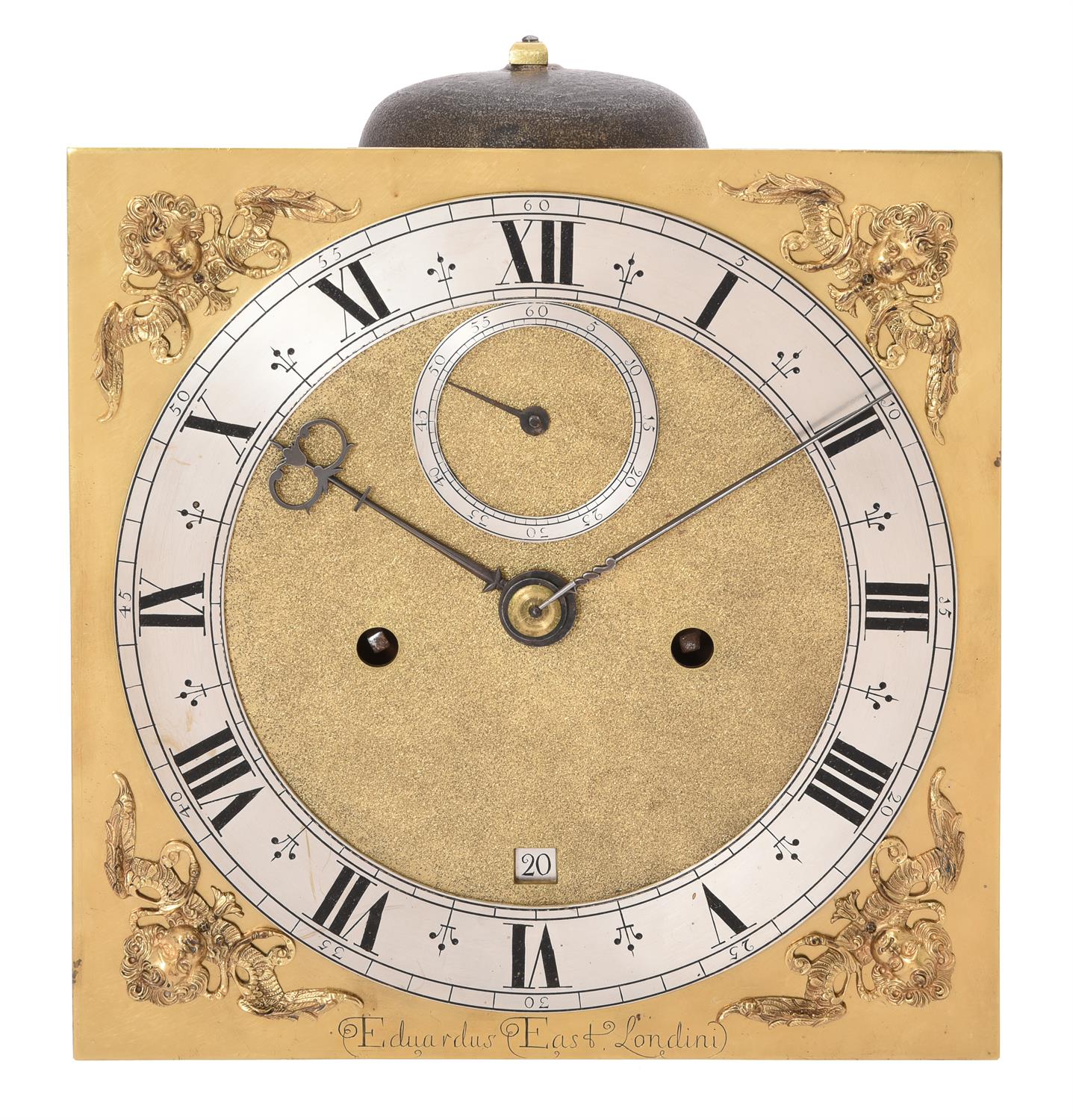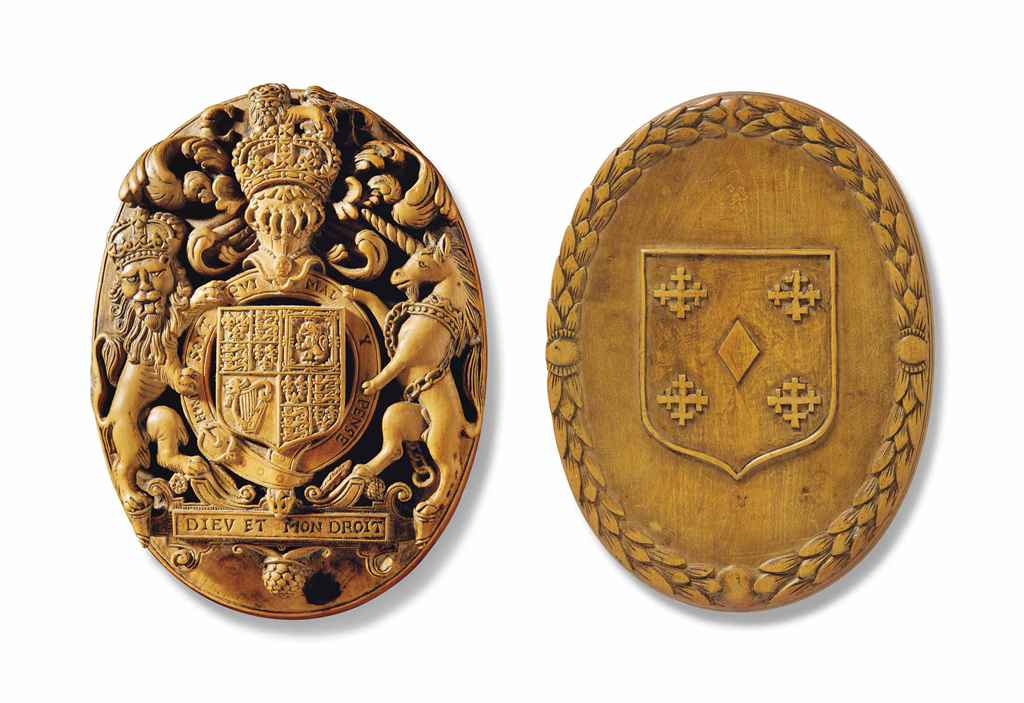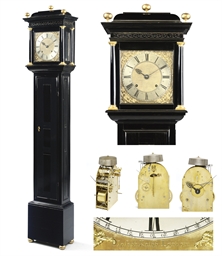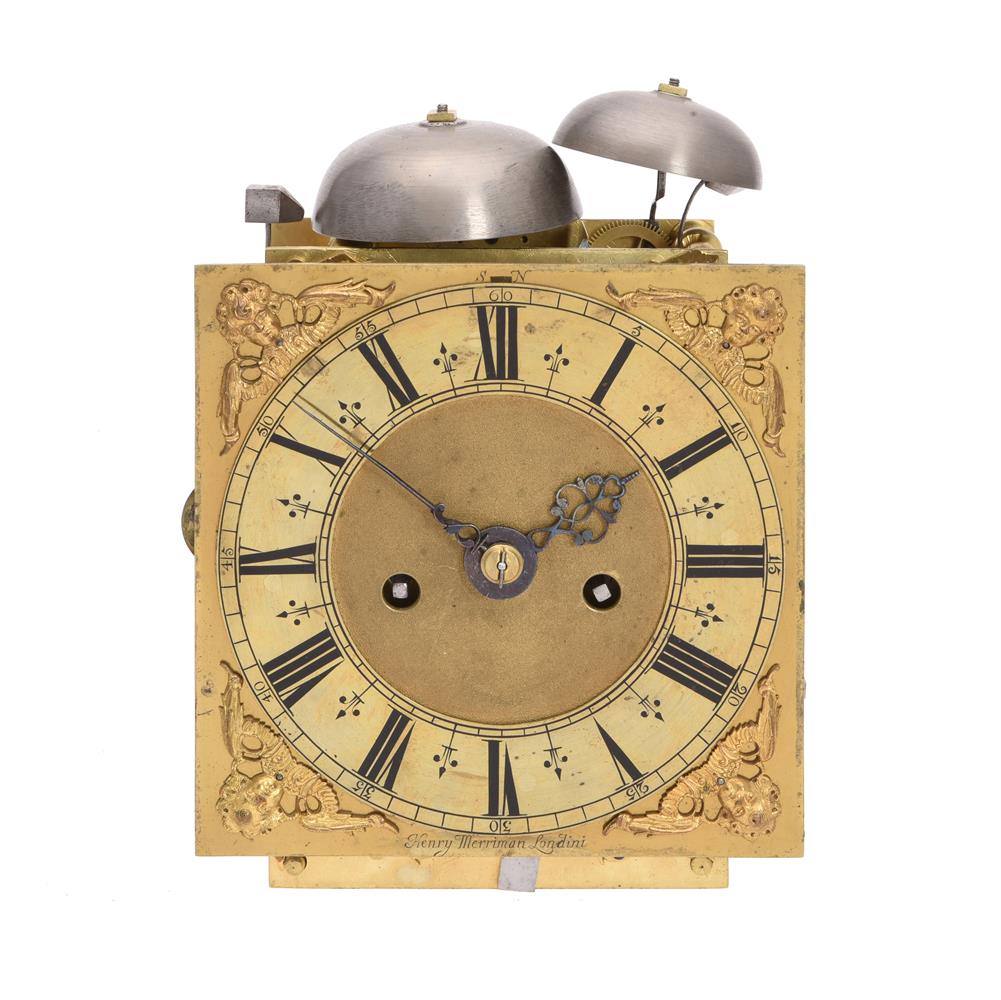A fine Charles II eight-day longcase clock movement with 10 inch dial Joseph Knibb London, circa 1685-90 The four knopped and finned pillar movement with rectangular plates measuring approximately 7.25 by 5 inches, the going train regulated by anchor escapement for a seconds period pendulum with pallet-shaped aperture cut to backplate, the strike train with external crossed-out countwheel and detent for sounding the hours on a bell mounted above the plates, the 10 inch square gilt brass dial with winding holes and high-position calendar aperture to the finely matted centre within applied 1.75 inch wide silvered Roman numeral chapter ring with stylised fleur-de-lys half hour markers and Arabic five minutes within the narrow outer track, the angles applied with winged cherub head and foliate scroll cast spandrels with foliate engraved infill between to each side and engraved signature Ioseph Knibb Londini Fecit to lower margin, (unrestored and with faults, lacking pendulum, weights and seatboard). Provenance: The estate of a connoisseur collector of regional furniture, works of art and clocks. Purchased at auction approximately sixty years ago with a view to having it restored and housed in an appropriate case. Joseph Knibb was born the fifth son of Thomas Knibb of Claydon, Oxfordshire in 1640. He is generally thought to have been apprenticed in around 1655 to his cousin Samuel Knibb in Newport Pagnell, before moving to Oxford circa 1662 (the same year that Samuel moved to London). Joseph initially struggled to trade in Oxford due to restrictions placed by the City authorities which were only relaxed on payment of a fine in 1668. It was about at this time that Joseph Knibb would have issued his copper trade tokens (an example of which was sold in these rooms 10th February 2009, lot 104 for £1,600 hammer) as well looking to undertake work to convert the turret clocks of St. Mary the Virgin and Wadham College to anchor escapement with long pendulum. In 1670 Joseph moved to London handing over the Oxford business to his younger brother, John. The reason for this move was probably to administer the estate of Samuel who is thought to have died by the summer of 1671. Joseph Knibb presumably took on Samuel's former workshop as by 1675 he was recorded as working from 'The Dyal' near Sargeants Inn in Fleet Street. By 1693 he had moved to 'The Clock Dyal' Suffolk Street, near Charing Cross. As Joseph became established in London his work became more individual/distinctive, often demonstrating an inventive and refined approach both in the detailing and specification of the movements and choice of case design. He is perhaps best known for his experimentation with alternative striking such as Dutch, Roman and double-six grande sonnerie as well as long duration clocks. In 1697 Joseph Knibb sold up the London business (presumably to Samual Aldworth, former apprentice of John Knibb of Oxford) and retired to Hanslop in Buckinghamshire where he died in December 1711. The current lot exhibits features that one would expect to see on an eight-day longcase movement by Joseph Knibb namely the crossed-out countwheel, lack of bridge for the hour wheel to the frontplate and pallet-shaped aperture to the backplate. The dial is also typical of Knibb's work with high position calendar aperture, stylised fleur-de-lys half hour markers and narrow inner quarter and outer minute tracks. The signature is particularly pleasing with the upright script being directly comparable to that on an earlier small walnut eight-day longcase clock which was sold in these rooms on Tuesday 17th March 2015, lot 86 for £65,000 hammer. Stylistically the dial can be dated to around 1685-90 and compares closely to that of a marquetry cased example illustrated in Lee, Ronald A. The Knibb Family * Clockmakers on Page 46 (plate 45). Although in somewhat tired and neglected condition the current lot presents as an eminently viable restoration project and offers the enthusiast a potent
A fine Charles II eight-day longcase clock movement with 10 inch dial Joseph Knibb London, circa 1685-90 The four knopped and finned pillar movement with rectangular plates measuring approximately 7.25 by 5 inches, the going train regulated by anchor escapement for a seconds period pendulum with pallet-shaped aperture cut to backplate, the strike train with external crossed-out countwheel and detent for sounding the hours on a bell mounted above the plates, the 10 inch square gilt brass dial with winding holes and high-position calendar aperture to the finely matted centre within applied 1.75 inch wide silvered Roman numeral chapter ring with stylised fleur-de-lys half hour markers and Arabic five minutes within the narrow outer track, the angles applied with winged cherub head and foliate scroll cast spandrels with foliate engraved infill between to each side and engraved signature Ioseph Knibb Londini Fecit to lower margin, (unrestored and with faults, lacking pendulum, weights and seatboard). Provenance: The estate of a connoisseur collector of regional furniture, works of art and clocks. Purchased at auction approximately sixty years ago with a view to having it restored and housed in an appropriate case. Joseph Knibb was born the fifth son of Thomas Knibb of Claydon, Oxfordshire in 1640. He is generally thought to have been apprenticed in around 1655 to his cousin Samuel Knibb in Newport Pagnell, before moving to Oxford circa 1662 (the same year that Samuel moved to London). Joseph initially struggled to trade in Oxford due to restrictions placed by the City authorities which were only relaxed on payment of a fine in 1668. It was about at this time that Joseph Knibb would have issued his copper trade tokens (an example of which was sold in these rooms 10th February 2009, lot 104 for £1,600 hammer) as well looking to undertake work to convert the turret clocks of St. Mary the Virgin and Wadham College to anchor escapement with long pendulum. In 1670 Joseph moved to London handing over the Oxford business to his younger brother, John. The reason for this move was probably to administer the estate of Samuel who is thought to have died by the summer of 1671. Joseph Knibb presumably took on Samuel's former workshop as by 1675 he was recorded as working from 'The Dyal' near Sargeants Inn in Fleet Street. By 1693 he had moved to 'The Clock Dyal' Suffolk Street, near Charing Cross. As Joseph became established in London his work became more individual/distinctive, often demonstrating an inventive and refined approach both in the detailing and specification of the movements and choice of case design. He is perhaps best known for his experimentation with alternative striking such as Dutch, Roman and double-six grande sonnerie as well as long duration clocks. In 1697 Joseph Knibb sold up the London business (presumably to Samual Aldworth, former apprentice of John Knibb of Oxford) and retired to Hanslop in Buckinghamshire where he died in December 1711. The current lot exhibits features that one would expect to see on an eight-day longcase movement by Joseph Knibb namely the crossed-out countwheel, lack of bridge for the hour wheel to the frontplate and pallet-shaped aperture to the backplate. The dial is also typical of Knibb's work with high position calendar aperture, stylised fleur-de-lys half hour markers and narrow inner quarter and outer minute tracks. The signature is particularly pleasing with the upright script being directly comparable to that on an earlier small walnut eight-day longcase clock which was sold in these rooms on Tuesday 17th March 2015, lot 86 for £65,000 hammer. Stylistically the dial can be dated to around 1685-90 and compares closely to that of a marquetry cased example illustrated in Lee, Ronald A. The Knibb Family * Clockmakers on Page 46 (plate 45). Although in somewhat tired and neglected condition the current lot presents as an eminently viable restoration project and offers the enthusiast a potent















Testen Sie LotSearch und seine Premium-Features 7 Tage - ohne Kosten!
Lassen Sie sich automatisch über neue Objekte in kommenden Auktionen benachrichtigen.
Suchauftrag anlegen